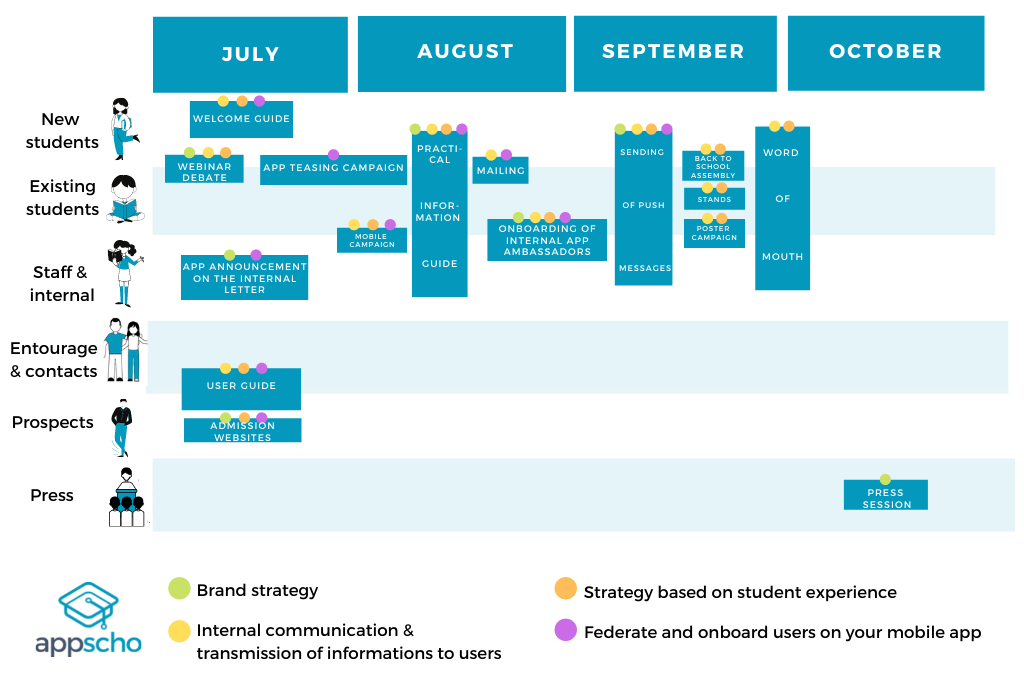[REPLAY WEBINAIRE] Réussir le lancement de son application mobile : l’Université de Nîmes vous donne les clefs du succès
By: Ready Education on 21 juil. 2021 12:28:00[REPLAY WEBINAIRE] Réussir le lancement de son application mobile : l’Université de Nîmes vous donne les clefs du succès
By: Ready Education 21 juil. 2021 12:28:00
On 5 July, we kicked off the ParlonsApp event with a special webinar dedicated to the integration of mobile into the communication strategy of RSE institutions*.
Through this webinar, our Project and Customer Experience Manager, Manon Plagnol, highlighted the contemporary challenges of the education sector and the communication methods to address them.
In this article, you will also find the key points of this webinar 👇
👨🎓 The mobile: a central element of student life
This webinar on integrating mobile into your communication strategy has been designed with the use of smartphones in mind.
It should be noted that:
98% of French 18/24-year-olds own a smartphone. This equipment rate is constantly increasing. It is, therefore, necessary to set up communication strategies that take into account these new tools.
In France, the average time spent using smartphones per day is 3.7 hours.
Since 2019, AppScho has counted over 21 million sessions. This is, therefore a large population that uses our mobile applications regularly.
Between September and December 2019, all AppScho mobile app users spent an average of 10 years on them.
These few figures demonstrate the value of using mobile applications to communicate.
🏫 Contemporary challenges in CSR*
A wide range of digital tools is being introduced in higher education institutions. This is leading to an increase in the complexity of digital systems in higher education institutions. Communication is becoming increasingly important.
On the student side, there is a strong demand for proximity coupled with a need to know daily the campus news.
Knowing how to use your mobile app to communicate at the right time and in the right way is a must. The goal is to integrate the app into the campus life of your students by facilitating their access to your digital ecosystem while creating a sense of belonging through the digital campus at your fingertips.
In short, use your institution's mobile application to create a community, facilitate access to the digital campus and become a digital one-stop shop.
📱Why communicate on mobile?
Screens are nowadays ubiquitous in our daily lives.
The mobile phone must therefore be considered a real-time tool. This means that when you receive information on your phone, it must be relevant at the time you receive it.
The read rates of messages sent on our mobile applications are very high in 2019. 3 out of 4 students click on messages sent by their institution.
Thus, the mobile communication strategy, provided it is relevant and adapted to your users, can generate a high rate of engagement. Indeed, we have observed that the reading rate of messages in 2019 is more than 75% of the opening rate against 30% for emails.
Mobile, therefore, allows you to measure the engagement of your students, whether it be through the time spent on the app, the number of sessions, users or even responses to mobile questionnaires.
💬 What communication strategy?
First, you need to consider the communication objectives you want to set for your mobile application.
Secondly, define your different targets. These can be high school students, parents, but also students and teachers. Which targets do you want to reach for which purposes? If you don't segment your audience, you risk sending the wrong messages to the wrong target and spamming your audience, who will then be likely to deactivate their notifications.
Then you have to think about the messages you want to convey. Indeed, you will not communicate in the same way on the app, depending on whether you want to present an event or make a reminder about another. The length of the text, the precision of the information… you have to adapt your speech.
You can have RSS feeds, for example, to share your events. All these elements will define what you will do with your mobile application.
💡
Appscho Tip: Don't communicate exclusively via your mobile application. You risk not reaching your entire community. You will have to duplicate your content and adapt it to your different communication channels. This is how you will achieve a much more effective communication strategy!
📣 The communication plan
Your primary goal is to create strong user acceptance of your mobile application. If you don't communicate about this tool, your community will be less likely to download it. It is important to grasp these issues.
You must therefore, as a first step, make your mobile application known, and this, as soon as the school year starts!
👭 What targets?
You will not communicate in the same way to all your students. You need to take into account the profile of each of your users.
You can then set up different ways of communicating in your institution depending on how you want to reach your targets!
🤔 What to communicate on mobile media?
This list is not intended to be exhaustive
The first important elements to communicate are useful information such as building closures, forbidden accesses… for example.
You can also communicate heavier content , via the Knowledge Base, on admissions, courses abroad, etc. These can also be useful tools for teachers.
Also include content about your campus activities : blood donation, vaccination, etc. Information that will be useful at the moment sent as a push message.
Finally, collect information on organized events … to get feedback from your audience.
💡
Appscho Tip: Focus on important content that will encourage your students to join in.
Parallel your communications by adapting them to each medium.
🌎 How do I organize and moderate my communications?
To implement this strategy, define your administrators and those who will be allowed to communicate via your app . The administrator is usually the sponsor or project manager on the school side.
Don't forget that, depending on the targets you want to reach, you can translate your messages. Do not hesitate to do so, especially in the case of exchanges with international students.
Finally, think about raising awareness in your departments and collecting the needs of your users . Some institutions open access to some of their student associations so that they can communicate on messaging.
If you communicate and train your users, your application will become a real asset in your communication strategy!
💡
Appscho Tip: Plan your content and push messages!
Don't be afraid of notifications, communicate and educate your employees on the best practices to follow.
📅 Where to start: making your mobile application known
Find a detailed back-to-school communication plan, resulting from work carried out with our partner institutions!

*ESR: Higher Education and Research

 Accueil du blog
Accueil du blog .png)
.png)
.png)


